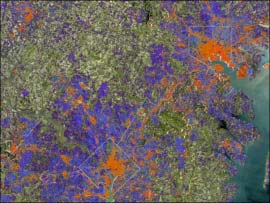Educational and Campus Footprint
 Impervious surface area in the Washington-Balitmore
Impervious surface area in the Washington-Balitmore
metro region along the Chesapeake Bay watershed
(orange=highly paved; blue=substantially paved).
The research agenda of GEI encompasses an inherent and substantial educational footprint, both in terms of curricular and experiential training for students. Simply put, incorporating an understanding of the linkages between environmental quality and human welfare must become an essential part of MIT’s basic educational message delivered in the classroom, the lab and the field. Therefore GEI will develop new educational programs to parallel and complement its research agenda, building on the solid foundation provided by many existing programs at MIT. In addition, GEI will support the ongoing effort to develop a new undergraduate Minor in Environment and Sustainability. A GEI Education Task Force will be created to help guide these efforts to ensure the direct impact of its research agenda on the training of future leaders in environmental science, engineering and planning.
But full campus involvement for GEI will entail much more than its footprint in formal educational programs. A truly transformative community at MIT focused on environment and sustainability must embrace and exploit all the enthusiasm, initiative and creative energy on campus—particularly from students, our greatest resource. Embracing and partnering with existing campus organizations (e.g. the student group Sustainability@MIT and the Office of Environment, Health and Safety) and programs (e.g. the Green Ambassadors Initiative and the Campus Energy “Walk the Talk” Task Force) will be a major emphasis for GEI as it evolves.
